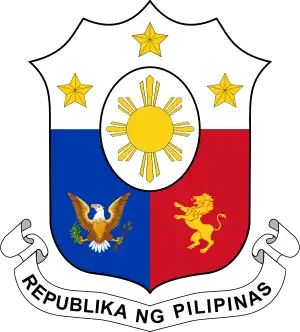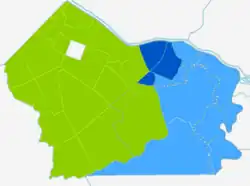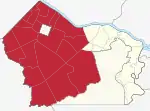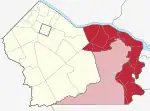Legislative districts of Makati
The legislative districts of Makati are the representations of the highly urbanized city of Makati in the various national legislatures of the Philippines. The city is currently represented in the lower house of the Congress of the Philippines through its first and second districts.
 |
|---|
|
|
History

1st district
2nd district under the de jure jurisdiction of Makati
2nd district under the de jure jurisdiction of Taguig
Areas now under the jurisdiction of Makati were initially represented as part of the at-large district of the province of Manila in the Malolos Congress from 1898 to 1899. The then-town was later incorporated to the province of Rizal, established in 1901, and was represented as part of the first district of Rizal from 1907 to 1941 and from 1945 to 1972. Then excluding the present-day Embo barangays and barangay Rizal,[1] Makati was incorporated to the City of Greater Manila during World War II and was represented as part of the at-large district of Manila from 1943 to 1944. Areas now under the jurisdiction of the aforementioned barangays, meanwhile, was part of the at-large district of Rizal during the war-time legislature. Makati was separated from Rizal on November 7, 1975 by virtue of Presidential Decree No. 824,[2] and was represented in the Interim Batasang Pambansa along with other Metropolitan Manila municipalities and cities as part of Region IV from 1978 to 1984.
Makati first gained separate representation in 1984, when it returned one representative to the Regular Batasang Pambansa. The municipality continued to constitute a separate congressional district under the new Constitution[3] proclaimed on February 11, 1987; it elected its member to the restored House of Representatives starting that same year.
Upon its cityhood, Makati was divided into two congressional districts by virtue of Section 52 of Republic Act No. 7854 (the City Charter of Makati),[4] enacted on January 2, 1995 and approved by plebiscite on February 4, 1995, the day Makati became a city. The districts first elected their separate representatives in the 1998 general elections.
There was a dispute over which city has jurisdiction over lands encompassed within the former Fort McKinley U.S. Military Reservation (now Fort Bonifacio and its surrounding areas). Portions of two of Makati's barangays (Post Proper Northside and Post Proper Southside) were claimed by the neighboring city of Taguig as part of its own four barangays (Fort Bonifacio, Pinagsama, Western Bicutan, and Ususan). Residents of areas where Makati exercised de facto control vote as part of the 2nd congressional district, while residents of areas where Taguig exercised de facto control vote as part of its first congressional district for Ususan and its second congressional district for Fort Bonifacio, Pinagsama, and Western Bicutan.
In April 2023, the Supreme Court has decided to junk Makati's petition to overrule its earlier decision to side with Taguig in the case of the Embo barangays, effectively placing these barangays into the jurisdiction of Taguig. The status of barangays Post Proper Northside and Post Proper Southside, meanwhile, are still unclear as they overlap Taguig's barangays Fort Bonifacio, Pinagsama, and Western Bicutan, respectively. An official transition and handover from Makati to Taguig are expected to happen.[5][6] With this, the fate of Makati's 2nd district is uncertain as its remaining barangays of Guadalupe Nuevo, Guadalupe Viejo, and Pinagkaisahan do not fulfill altogether the constitutional requirement of 250,000 residents. Makati could be reduced back to a single district with Taguig–Pateros gaining a district,[7] but pending legislation, the status quo of its existence is expected to prevail.[8]
Historical and defunct district boundaries
| District boundary changes | ||||||||
|---|---|---|---|---|---|---|---|---|
| Year | Map | District constituencies (City/Municipality) | ||||||
| 1984–1986 | ||||||||
| Lone: Bangkal, Bel-Air, Carmona, Dasmariñas, Forbes Park, Guadalupe Nuevo, Guadalupe Viejo, Kasilawan, La Paz, Magallanes, Olympia, Palanan, Pinagkaisahan, Pitogo, Pio del Pilar, Poblacion, San Antonio, San Isidro, San Lorenzo, Santa Cruz, Singkamas, Tejeros, Urdaneta, Valenzuela |
Makati | |||||||
| 1987–1996 | ||||||||
| Lone: Bangkal, Bel-Air, Carmona, Cembo, Comembo, Dasmariñas, East Rembo, Forbes Park, Guadalupe Nuevo, Guadalupe Viejo, Kasilawan, La Paz, Magallanes, Olympia, Palanan, Pembo, Pinagkaisahan, Pitogo, Pio del Pilar, Poblacion, Post Proper Northside, Post Proper Southside, San Antonio, San Isidro, South Cembo, San Lorenzo, Santa Cruz, Singkamas, Tejeros, Urdaneta, Valenzuela, West Rembo | ||||||||
| 1996–1998 | ||||||||
| Lone: Bangkal, Bel-Air, Carmona, Cembo, Comembo, Dasmariñas, East Rembo, Forbes Park, Guadalupe Nuevo, Guadalupe Viejo, Kasilawan, La Paz, Magallanes, Olympia, Palanan, Pembo, Pinagkaisahan, Pitogo, Pio del Pilar, Poblacion, Post Proper Northside, Post Proper Southside, Rizal, San Antonio, San Isidro, South Cembo, San Lorenzo, Santa Cruz, Singkamas, Tejeros, Urdaneta, Valenzuela, West Rembo | ||||||||
| 1998–present | ||||||||
| 1st: Bangkal, Bel-Air, Carmona, Dasmariñas, Forbes Park, Kasilawan, La Paz, Magallanes, Olympia, Palanan, Pio del Pilar, Poblacion, San Antonio, San Isidro, San Lorenzo, Santa Cruz, Singkamas, Tejeros, Urdaneta, Valenzuela | ||||||||
| 2nd: Cembo, Comembo, East Rembo, Guadalupe Nuevo, Guadalupe Viejo, Pembo, Pinagkaisahan, Pitogo, Post Proper Northside, Post Proper Southside, Rizal, South Cembo, West Rembo | ||||||||
Historical representatives
Current districts and representatives
The city was last redistricted in 1998, wherein the city gained a second seat in the House of Representatives.
Political parties
| District | Current representative | Barangays | Population (2020) | Area | Map | ||
|---|---|---|---|---|---|---|---|
| 1st |  |
Romulo Peña Jr. (since 2019) Valenzuela |
List
|
254,600[9] | 9.03 km² |  | |
| 2nd | .jpg.webp) |
Luis Angel Jose Campos (since 2016) West Rembo |
List
|
375,016[9] | 13.62 km² |  | |
Notes
References
- Map of the City of Manila (Map). 1:40,000. Division of Drafting and Surveys, Office of the City Engineer and Architect, City of Manila. 1942. Retrieved August 29, 2022.
- Presidential Decree No. 824 (7 November 1975). Creating the Metropolitan Manila and the Metropolitan Manila Commission and for Other Purposes. Retrieved October 10, 2017.
- 1986 Constitutional Commission (February 2, 1987). "1987 Constitution of the Philippines - Apportionment Ordinance". Retrieved October 9, 2017.
- Republic Act No. 7854 (19 July 1994). An Act Converting the Municipality of Makati into a Highly Urbanized City to be Known as the City of Makati. Retrieved August 29, 2022.
- Hicap, Jonathan (April 3, 2023). "Taguig LGU lauds SC decision over Fort Bonifacio ownership". Manila Bulletin.
- Cayabyab, Marc Jayson (April 5, 2023). "Makati raises 'constitutional' issues in BGC land dispute". The Philippine Star. Retrieved April 6, 2023.
- Aurelio, Julie (22 July 2023). "SC ruling opens issue on Taguig House seats". Philippine Daily Inquirer. Retrieved 23 July 2023.
- "After SC ruling, Makati's congressional seat hangs in the balance". Rappler. 26 July 2023. Retrieved 27 July 2023.
- "Philippine Statistics Authority | Republic of the Philippines". Philippine Statistics Authority. Retrieved June 16, 2022.